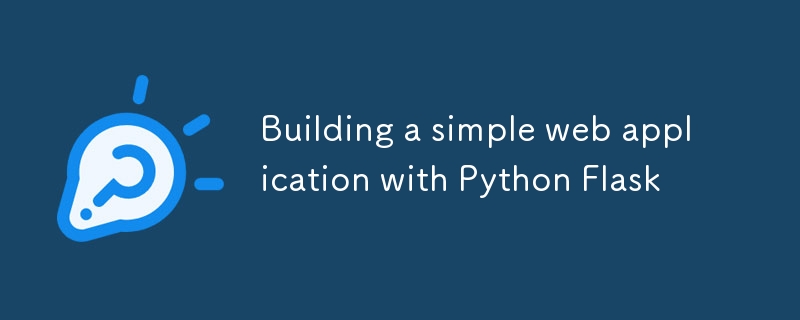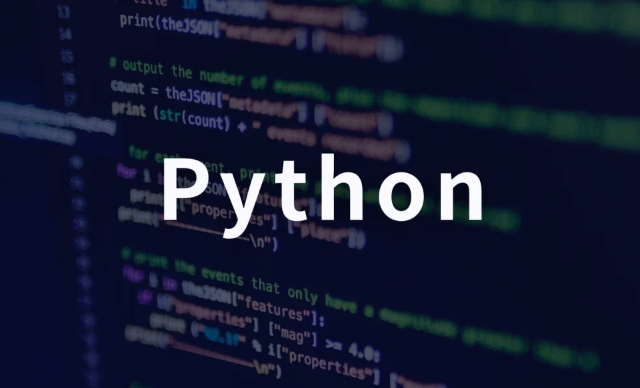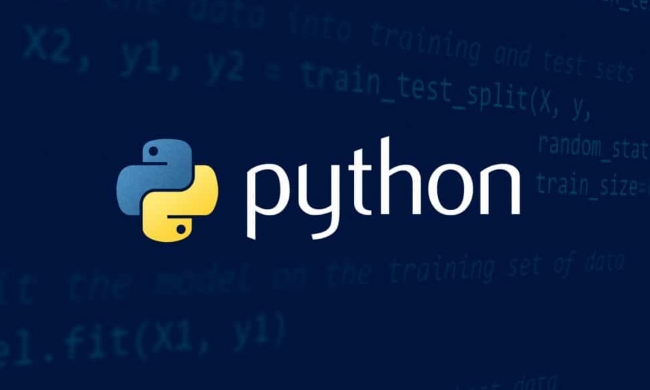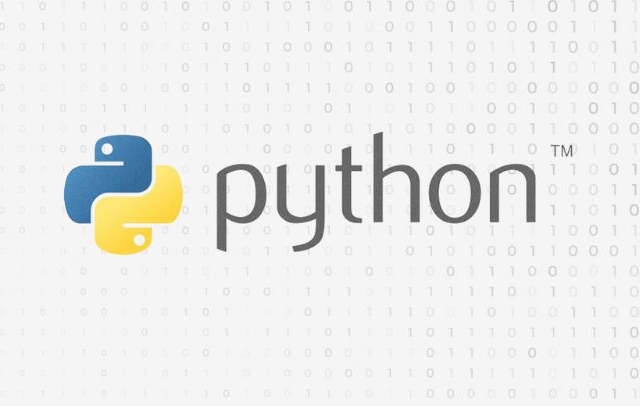Flask is a lightweight web framework for beginners, and can be used to quickly build simple websites. 1. Before installing Flask, you should create a virtual environment and install it using pip; 2. The project structure usually includes the main program file app.py, template folder templates, and static resource folder static; 3. Use @app.route() to define routes and return response content, supporting HTML page rendering; 4. When adding CSS or JavaScript files, you must place it in the static folder and reference it through the /static/ path; 5. Support dynamic routing and form processing, and you can receive user input through the request module. Through these basic functions, more complex applications can be gradually expanded.

Flask is a very lightweight but powerful framework in Python, which is suitable for building simple web applications. It is fast to get started and has a clear structure, which is especially suitable for beginners or developers who need to quickly implement small projects.

Install Flask and create a project structure
First, you need to install Flask. It is recommended to operate in a virtual environment, so that it will not affect the global Python package. You can use venv to create a virtual environment:
python -m venv venv source venv/bin/activate # venv\Scripts\activate on Windows pip install flask
Then, create a new project folder, such as myapp , which contains a main program file, usually named app.py or main.py The basic structure is as follows:

myapp/
├── app.py
└── templates/
└── index.html Flask will look for HTML templates in the templates folder by default, so this structure is convenient for subsequent page content.
Write the first route and response
Open app.py and write a basic Hello World example first:

from flask import Flask, render_template
app = Flask(__name__)
@app.route('/')
def home():
return "Hello, Flask!"The operation method is also very simple, execute it on the command line:
flask run
By default, the local http://127.0.0.1:5000/ will be started, and you can see the output content by accessing.
If you want to return an HTML page instead of plain text, you can change return :
return render_template('index.html')
Then create the corresponding HTML file in the templates folder.
Add static resources and multiple pages
If you want to add CSS or JavaScript files, you can create a static folder in the project root directory, with the structure like this:
myapp/
├── app.py
├── static/
│ ├── style.css
│ └── script.js
└── templates/
└── index.html When referencing these files in HTML, use the path format of /static/文件名, for example:
<link rel="stylesheet" href="/static/style.css"> <script src="/static/script.js"></script>
As for multiple pages, you only need to continue adding routing functions, such as:
-
/aboutdisplay about page -
/contactdisplay contact information - Each page corresponds to a
@app.route()and a template file
Use variables and form processing (optional advanced)
If you want to make the web page more dynamic, you can use variables to pass the data. For example:
@app.route('/greet/<name>')
def greet(name):
return f"Hello, {name}!" You can also use the request module to receive POST requests and process the data submitted by users:
from flask import request
@app.route('/login', methods=['POST'])
def login():
username = request.form.get('username')
return f"Welcome, {username}!"Of course, front-end HTML needs to cooperate with writing a form:
<form action="/login" method="post"> <input type="text" name="username"> <button type="submit">Submit</button> </form>
Basically that's it. Flask is simple, but it is very flexible. You can start from here and gradually add functions such as database, login verification, front-end and back-end separation to slowly build a more complete application.
The above is the detailed content of Building a simple web application with Python Flask. For more information, please follow other related articles on the PHP Chinese website!

Hot AI Tools

Undress AI Tool
Undress images for free

Undresser.AI Undress
AI-powered app for creating realistic nude photos

AI Clothes Remover
Online AI tool for removing clothes from photos.

Clothoff.io
AI clothes remover

Video Face Swap
Swap faces in any video effortlessly with our completely free AI face swap tool!

Hot Article

Hot Tools

Notepad++7.3.1
Easy-to-use and free code editor

SublimeText3 Chinese version
Chinese version, very easy to use

Zend Studio 13.0.1
Powerful PHP integrated development environment

Dreamweaver CS6
Visual web development tools

SublimeText3 Mac version
God-level code editing software (SublimeText3)

Hot Topics
 Polymorphism in python classes
Jul 05, 2025 am 02:58 AM
Polymorphism in python classes
Jul 05, 2025 am 02:58 AM
Polymorphism is a core concept in Python object-oriented programming, referring to "one interface, multiple implementations", allowing for unified processing of different types of objects. 1. Polymorphism is implemented through method rewriting. Subclasses can redefine parent class methods. For example, the spoke() method of Animal class has different implementations in Dog and Cat subclasses. 2. The practical uses of polymorphism include simplifying the code structure and enhancing scalability, such as calling the draw() method uniformly in the graphical drawing program, or handling the common behavior of different characters in game development. 3. Python implementation polymorphism needs to satisfy: the parent class defines a method, and the child class overrides the method, but does not require inheritance of the same parent class. As long as the object implements the same method, this is called the "duck type". 4. Things to note include the maintenance
 Python Function Arguments and Parameters
Jul 04, 2025 am 03:26 AM
Python Function Arguments and Parameters
Jul 04, 2025 am 03:26 AM
Parameters are placeholders when defining a function, while arguments are specific values ??passed in when calling. 1. Position parameters need to be passed in order, and incorrect order will lead to errors in the result; 2. Keyword parameters are specified by parameter names, which can change the order and improve readability; 3. Default parameter values ??are assigned when defined to avoid duplicate code, but variable objects should be avoided as default values; 4. args and *kwargs can handle uncertain number of parameters and are suitable for general interfaces or decorators, but should be used with caution to maintain readability.
 Explain Python generators and iterators.
Jul 05, 2025 am 02:55 AM
Explain Python generators and iterators.
Jul 05, 2025 am 02:55 AM
Iterators are objects that implement __iter__() and __next__() methods. The generator is a simplified version of iterators, which automatically implement these methods through the yield keyword. 1. The iterator returns an element every time he calls next() and throws a StopIteration exception when there are no more elements. 2. The generator uses function definition to generate data on demand, saving memory and supporting infinite sequences. 3. Use iterators when processing existing sets, use a generator when dynamically generating big data or lazy evaluation, such as loading line by line when reading large files. Note: Iterable objects such as lists are not iterators. They need to be recreated after the iterator reaches its end, and the generator can only traverse it once.
 Python `@classmethod` decorator explained
Jul 04, 2025 am 03:26 AM
Python `@classmethod` decorator explained
Jul 04, 2025 am 03:26 AM
A class method is a method defined in Python through the @classmethod decorator. Its first parameter is the class itself (cls), which is used to access or modify the class state. It can be called through a class or instance, which affects the entire class rather than a specific instance; for example, in the Person class, the show_count() method counts the number of objects created; when defining a class method, you need to use the @classmethod decorator and name the first parameter cls, such as the change_var(new_value) method to modify class variables; the class method is different from the instance method (self parameter) and static method (no automatic parameters), and is suitable for factory methods, alternative constructors, and management of class variables. Common uses include:
 How to handle API authentication in Python
Jul 13, 2025 am 02:22 AM
How to handle API authentication in Python
Jul 13, 2025 am 02:22 AM
The key to dealing with API authentication is to understand and use the authentication method correctly. 1. APIKey is the simplest authentication method, usually placed in the request header or URL parameters; 2. BasicAuth uses username and password for Base64 encoding transmission, which is suitable for internal systems; 3. OAuth2 needs to obtain the token first through client_id and client_secret, and then bring the BearerToken in the request header; 4. In order to deal with the token expiration, the token management class can be encapsulated and automatically refreshed the token; in short, selecting the appropriate method according to the document and safely storing the key information is the key.
 What are Python magic methods or dunder methods?
Jul 04, 2025 am 03:20 AM
What are Python magic methods or dunder methods?
Jul 04, 2025 am 03:20 AM
Python's magicmethods (or dunder methods) are special methods used to define the behavior of objects, which start and end with a double underscore. 1. They enable objects to respond to built-in operations, such as addition, comparison, string representation, etc.; 2. Common use cases include object initialization and representation (__init__, __repr__, __str__), arithmetic operations (__add__, __sub__, __mul__) and comparison operations (__eq__, ___lt__); 3. When using it, make sure that their behavior meets expectations. For example, __repr__ should return expressions of refactorable objects, and arithmetic methods should return new instances; 4. Overuse or confusing things should be avoided.
 How does Python memory management work?
Jul 04, 2025 am 03:26 AM
How does Python memory management work?
Jul 04, 2025 am 03:26 AM
Pythonmanagesmemoryautomaticallyusingreferencecountingandagarbagecollector.Referencecountingtrackshowmanyvariablesrefertoanobject,andwhenthecountreacheszero,thememoryisfreed.However,itcannothandlecircularreferences,wheretwoobjectsrefertoeachotherbuta
 Describe Python garbage collection in Python.
Jul 03, 2025 am 02:07 AM
Describe Python garbage collection in Python.
Jul 03, 2025 am 02:07 AM
Python's garbage collection mechanism automatically manages memory through reference counting and periodic garbage collection. Its core method is reference counting, which immediately releases memory when the number of references of an object is zero; but it cannot handle circular references, so a garbage collection module (gc) is introduced to detect and clean the loop. Garbage collection is usually triggered when the reference count decreases during program operation, the allocation and release difference exceeds the threshold, or when gc.collect() is called manually. Users can turn off automatic recycling through gc.disable(), manually execute gc.collect(), and adjust thresholds to achieve control through gc.set_threshold(). Not all objects participate in loop recycling. If objects that do not contain references are processed by reference counting, it is built-in






